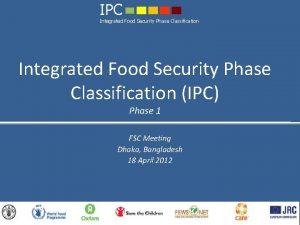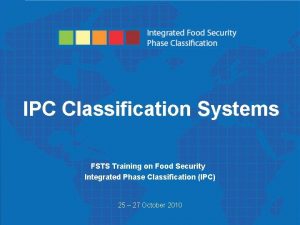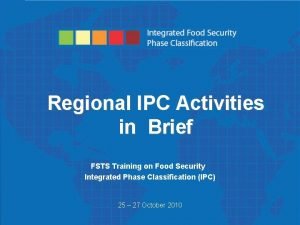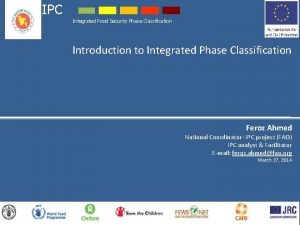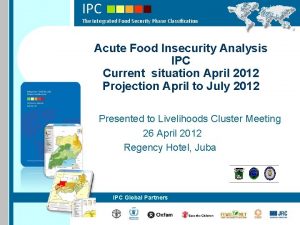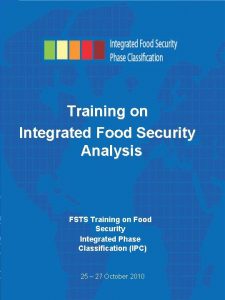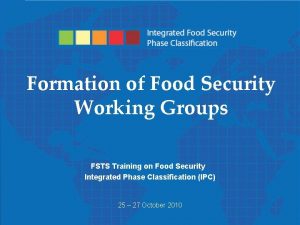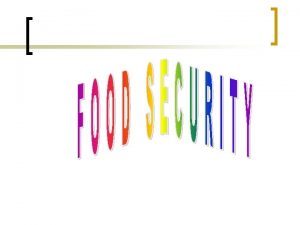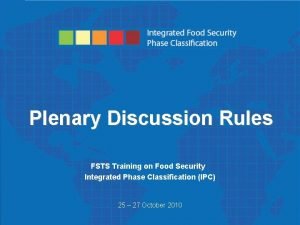IPC Integrated Food Security Phase Classification IPC What












- Slides: 12

IPC Integrated Food Security Phase Classification (IPC)

What is the IPC? • The IPC is a set of tools and procedures to classify the nature and severity of food insecurity for decision support. • The IPC classifies areas with Acute Food Insecurity into five Phases. Each of these Phases has different implications for response objectives. • The IPC classifies the severity of the situation for two time periods: the current situation and for a future projection. The future projection provides an early warning statement for proactive decision making.

A common approach Allowing comparability over space and time

IPC allows… • A common approach to classify food security • Integrated food security analysis • Technical consensus based on transparent evidence-based analysis • Increased relevance to strategic decision making Enabling interventions to be more needs-based, needs-based strategic, timely and integrated

What is the IPC? • The purpose of the IPC is to consolidate complex analysis of food security situations for evidence-based decision support. • The IPC aims for optimal decision support, recognizing in reality there will be less than ideal data and evidence. • Thus, the approach of the IPC is to make the best use of what evidence is available, but to do so in a rigorous and transparent manner. • The IPC is a set of tools and procedures to classify the nature and severity of food insecurity for decision support. • The IPC classifies areas with Acute Food Insecurity into five Phases: Minimal, Stressed, Crisis, Emergency, and Famine. Each of these Phases has different implications for response objectives. • The IPC classifies the severity of the situation for two time periods: the current situation and for a future projection. The future projection provides an early warning statement for proactive decision making.

The Four Functions of IPC 1. Building Technical Consensus Purpose: To enable technical consensus from multi sectoral experts and endorsement by key stakeholders. Tools: Technical Working Group Composition Matrix 2. Classifying severity & causes Purpose: To classify complex information on severity and causes into meaningful categories for decision support. Tools: IPC Analytical Framework, Acute Reference Tables, Chronic Reference Table, Analysis Worksheets 3. Communicating for action Purpose: To communicate core aspects of situation analysis in a consistent, accessible, and effective manner. Tools: IPC Communication Template 4. Quality Assurance Purpose: To ensure technical rigor and neutrality of analysis. Tools: Technical Working Group Self Assessment Tool, Peer Review Assessment Tool

IPC – Worldwide (as of Feb 2012) 1 Somalia 16 Yemen 2 Kenya 17 Myanmar 3 Uganda 18 Cambodia 4 Tanzania 19 Laos 5 South Sudan 20 Indonesia 6 North Sudan 21 Burundi 7 Djibouti 22 DRC 8 Rwanda 23 Ivory Coast 9 Tajikistan 24 South Africa 10 Afghanistan 25 Zimbabwe 11 Pakistan 26 Guatemala 12 Haiti 27 Nicaragua 13 Malawi 28 Honduras 14 Senegal 29 El Salvador 15 Niger 30 Mozambique Nepal

IPC in Pakistan • Integrated Food Security Phase Classification in Pakistan is a project funded by the ECHO, jointly implemented by FAO and WFP under the auspices of the National Ministry for Food Security and Research.

IPC Phase II May 2013 – April 2014 Title: • Food Security and Livelihoods analysis and response frameworks in Pakistan Objective: The project is to introduce IPC for standardized Food Classification for Advocacy, Planning and Response in Food Security and Nutrition interventions at National and Regional Level. • Improve decision-making mainly through analysis and coordination with in the food security sector Result: • In-country capacity on IPC consolidated, enhanced and institutionalized as a standard tool for integrated food security analysis Plan: • Technical Working groups • Capacity Building • Awareness raising • Research/Analysis

IPC Training and Analysis Workshop Objectives • To strengthen evidence based food security coordination and analysis for improved programming. • IPC is embedded within the disaster monitoring/response planning mechanism of GOP and GOP assumes ownership of the IPC process before project completion. • In-country capacity on IPC consolidated, enhanced and institutionalized as a standard tool for integrated food security analysis Structure • • • Presentations Discussion Group Work Data analysis Work sheets

Intended Output • Improved IPC networks through the formation of Provincial level technical working group under ownership of gov't • A certified pool of at least 60 food security experts are fully trained in IPC level 1. 0 and are able to conduct further IPC trainings and analysis independently • Data review/analysis and production of IPC Acute Classification products (map & report) at provincial level, IPC maps will be used as a decision-making tool by the members of the Food Security Cluster for their preparedness and response planning. • Enhanced awareness on significance of updating consistent, reliable and quality data on IPC indicators for IPC analysis • At least 10% of active members will use the IPC product for response planning. •

Thanks
 Integrity in e commerce
Integrity in e commerce Private secuirty
Private secuirty What is food safety
What is food safety Unit 2 food food food
Unit 2 food food food Grazing food chain diagram
Grazing food chain diagram Normal phase vs reverse phase chromatography
Normal phase vs reverse phase chromatography M tswett pronunciation
M tswett pronunciation Mobile phase and stationary phase
Mobile phase and stationary phase Mobile phase vs stationary phase
Mobile phase vs stationary phase Normal phase vs reverse phase chromatography
Normal phase vs reverse phase chromatography Difference between phase voltage and line voltage
Difference between phase voltage and line voltage Adsorption chromatography
Adsorption chromatography Phase to phase voltage
Phase to phase voltage













